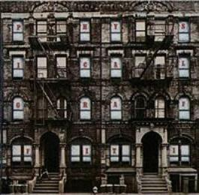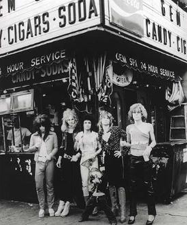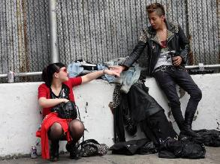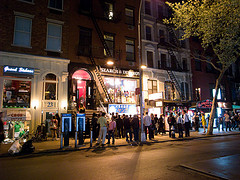In the Bones of Giants
Main Article Content
Abstract
My middle name, Joseph, is in honor of my paternal grandfather. It is customary among European Jews to name a child after a loved one who is dead. This has given me cause to frequently wonder why a deceased relative is chosen for the honor, while choosing a living relative is, if not proscribed, frowned upon. In unkind moments, I imagine it has to do with not wanting the actual people getting in the way of how we want to remember them. To “dismember” and to “remember” are not clear opposites, as “disassemble” and “reassemble” are. The “member” portions of the words are the same somewhat out of circumstance, though I still suspect a relation, if not a literal one. It is possible to remember people or places while they still exist, but it is more common, and somehow easier to do so after they have passed from the earth.

Fig. 1. Doud, Mike. Album cover. Led Zeppelin. Physical Graffiti. Atlantic, 1975. CD.
Walking the stretch of St. Mark’s Place between First and Third Avenues, I suspect that the street is something of a dying relative to certain New Yorkers. We love it, and we dutifully visit it because of what it once meant to us. At the same time, we cannot help notice how infirm it seems, and that, in its dementia, it no longer recognizes us, nor us, it. Perhaps, we think, it might be better once it is simply gone and we could get on with the business of remembering it in whatever idealized fashion we choose—idealizing ourselves along with it. This is a street steeped in rich history to the right kind of people: punks, Yippies, metalheads, anarchists and jazz greats—freaks all. For most of the last century, it remained steadfastly squalid and cheap, regardless of the gentrification around it. Walk along its length and you will pass the former haunts of Abbie Hoffman, Yoko Ono, Andy Warhol, Keith Haring, G.G. Allin, and Lenny Bruce. In cramped, sweaty bars, the Ramones held court, as did Guns N’ Roses, Iggy Pop, Thelonious Monk, The Velvet Underground, and the New York Dolls. If you were too weird or too poor for the rest of New York City, this was home. Normal people didn’t bother you here. The stinking derelicts, petty theft fences, and clusters of demonic-looking punks saw to it that your nickel of dirt weed could be smoked in peace on a warm night, sitting on stoops immortalized by the Stones and Led Zeppelin. This wasn’t heaven, but it felt like it sometimes.

Fig. 2. Unknown artist. Album art. The New York Dolls. The New York Dolls. Mercury, 1973. CD.
Now the street is something very different, though still slightly strange if only because of the proliferation of Japanese izakayas. The storefronts—once boarded up or filled with music venues, used-record stores, or crust-punk clothing shops—now host a fairly standard array of college bars, jewelry stores, and yogurt peddlers. For a while, there was even a Gap. Cleanly scrubbed students walk the blocks brightly chirping into bedazzled pink cell phones. Tourists dare to waddle about clutching maps and ice cream cones, their exposed fanny packs full of passports and cash, a telling sign of just how safe they feel here.
Indeed, St. Mark’s Place has become a museum of itself, down to the snack bars and gift shops. Go into the store Search and Destroy and for a hefty price you can attire yourself in bullet belts and bondage pants like a punk of yore. A guy I know gives rock-and-roll walking tours, so there is even a tour guide and plenty of police acting as guards. In Present Pasts: Urban Palimpsests and the Politics of Memory, Andreas Huyssen points out that this is not at all uncommon or unprecedented. Huyssen references Herman Lübbe, who “showed how musealization was no longer bound to the institution of the museum . . . but had come to infiltrate all areas of everyday life” (22). St. Mark’s Place is clearly such a monument, but what kind? Who curates such a museum (mausoleum?) and why? More importantly, can a place still be “alive” and yet function in this self-referential fashion?
In The Necessity for Ruins, John Jackson gives us two broad categories into which monuments fall. The first is the “hortatory sort,” which functions to “remind us of something important. That is to say, it puts people in mind of some obligation they have incurred” (90–91). Those who spent, or misspent, some of their youth on these streets might agree that it reminds them of something important, certainly, but the societal covenant or standard of behavior Jackson references isn’t readily apparent. The second is what Jackson refers to as the “contemporary American celebration,” which
suggests that the past is a remote, ill-defined period or environment when a kind of golden age prevailed, when society had an innocence or a simplicity that we have since lost; a period usually referred to as The Old Days, or as (Eliade calls it) in illo tempore—in those days— a time without significant events, and a landscape without monuments. (98)
In order to categorize St. Mark’s, we have to consider the use of the space by various classes of people. This is complicated by virtue of it being a “living” monument. By this, I mean that it is not specifically a space set aside for remembrance in a prescribed way. In a traditional monument, such as a museum, there is a triangular relationship between the exhibit itself, the curators, and the tourists. In an area where people live, work, and enjoy themselves more or less as they see fit, this triangular relationship is complicated by the denizens of the space and a group I call the “re-creationists.”

Fig. 3. Myshyyev, Timur. Untitled. 2009. Photograph. NYCityWatch. Web. 21 May 2009.
If you go to St. Mark’s now, you will see young people of high school and college age dressing and acting like the punks of the 1970s, ’80s and ’90s. They sit on stoops, beg for money, ride skateboards, and do their level best to recreate some indeterminate past that they were not actually alive to see. They are mostly middle-class kids chasing a scene that no longer exists. It’s as if you built Colonial Williamsburg, and people just started showing up and acting like blacksmiths and town criers for free. I would posit that to them, St. Mark’s is a blending of both of Jackson’s modes. Jackson describes them—and their hortatory motivation for using the space—when he quotes the orator at a monument dedication from the 1830s: “monuments are lasting incentives, to those who view them, to imitate the virtues they commemorate, and attain, by their life and spirit, glory and honor” (92). Perhaps “glory and honor” are not exactly the right words for whatever constitutes the punk aesthetic, but the general sentiment seems to apply.
To be clear though, the nostalgic draw of St. Mark’s shops and punks, this “marketing of memory” (Huyssen 15), is very different from the specific circumstances and needs that gave rise to the memory in the first place. In fact, they can be diametrically opposed. The used-record and clothing stores operated on the principle of artistic poverty: by buying goods from people with nothing left to sell and selling them to people with only slightly more. These types of stores existed because the proprietors could not afford better either. Now, the shopkeepers cater to and have, to a certain extent, participated in the recent wealth of the area.
Even so, by their look and their “spatial acting out of a place” (98), as Michel de Certeau puts it in his book The Practice of Everyday Life, the re-creationists and the old shopkeepers of the remaining punk clothing and used-record stores provide a link to the area’s past: essentially, they are curating the space as well as being part of the exhibit. Certeau’s concept offers a model for understanding a place where the interactions of the participants with the space are paramount. On St. Mark’s, the re-creationists and old shopkeepers enunciate their portion of the “language” of the street by being largely static. Both groups confine themselves to the “phrases” given shape by their stores and apartments, the pseudo punks limited by the stoops and sidewalks, moving usually only when rousted by the police. By these groups’ actions, and the confined nature of their actions, one can easily compare them to a more traditional monument.
Furthermore, the new shopkeepers, with their expensive jewelry and international foods, suggest a new language existing next to, or perhaps on top of, the old. The spaces occupied are the same, but the new content and the new users provide a completely different set of possible “modalities of pedestrian enunciation;” they
include the kinds of relationship this enunciation entertains with particular paths (or “statements”) by according them a truth value (“alethic” modalities of the necessary, the impossible, the possible or the contingent), an epistemological value (“epistemic” modalities of the certain, the excluded the plausible or the questionable), or finally an ethical or legal value (“deodontic” modalities of the obligatory, the forbidden, the permitted, or the optional). (Certeau 99)
The spaces are similar to what they used to be, and in one or two cases, the stores are even the same, but the uses according to all three modalities (alethic, epistemic, and deodontic) are quite different. Squatting without purpose is no longer encouraged or permitted, nor is illegal activity such as drug use or the resale of “slightly used” home audio gear. The music blaring from venues, homes, and boom boxes is gone. In their place are the polite and brisk enunciations of commerce, tourism, and collegiate binge drinking. The new pedestrian additions to the area redefine the space to encourage movement rather than squatting or confined mobility. Pedestrians tour the area and walk up and down its length. They briefly stop to sit at sidewalk cafes or make purchases. They hop from bar to bar, and then head off to someplace else.
I’m reminded of a scene from the movie Excalibur in which Albion is in ruin and Arthur rides one final time to confront Mordred and Morgana le Fay. As he passes, the land is renewed and blooms in his wake. Behind these new walkers in St. Mark’s remain fresh coats of paint, Ramen-yas, bubble tea stalls, and Chipotle franchises. Watching this process play out over time, you can see that in a market-driven system, the space is also curated by the users. They choose the bulk of exhibits, how one interacts with them, and even the “suggested donation” by choosing how much they are willing to pay for entrance and interaction with the space. In addition, it is they who make St. Mark’s—no longer predatory and filthy—safe enough for the re-creationists, though I do not think the latter group would ever admit to such a thing. The fact of the matter is, that while they complain about how these blocks are no longer punk, it is unlikely that they would have been willing or able to exist there when it truly was.

Fig. 4. Beale, Scott. “St. Marks Place.” 2008. Photograph. Flickr. Web. 11 Dec. 2012.
Like any “living” monument, St. Mark’s place is fluid and shifting, curated by many people in various groups. It takes the form and function of Jackson’s modes of monumentality, depending in part on whom you might ask. The re-creationist punks and the old shopkeepers curate and use the space, begrudgingly guided and supported by the tourists who spend their time and money there. This is natural, unavoidable, and—might I even suggest—healthy, because “there is no pure space outside of commodity culture, however much we may desire such a space” (Huyssen 19). To me and to others of older generations, it is a monument because we have grown conscious that we ourselves are dying. As we feel our mortality, we look to something more permanent, something that lives on, as this space does via the new life given it by the very changes it has undergone. As we lose relevance and fade, the space can carry some little piece of us into the future.
It is this very process that makes something a monument. Something must pass so that there is a will to recall it. The new generations of users of the space, those to whom it is not a monument or whose view of it is radically different from that of the older generation, need us to get out of their way so they can continue to define the space without our interference or insistence that it must mean the same to them as it did to us. This insistence is pure “codgery” and best explained by comparing us to Certeau’s “Ministers of Knowledge,” who “have always assumed that the whole universe was threatened by the very changes that affected their ideologies and their positions. They transmute the misfortune of their theories into theories of misfortune” (95–96). This street is thousands of monuments to thousands of people, and each one of those winks out as those people shuffle off. In the room cleared by our exit, and the quieting of voices insisting that it means this or that, a living space like St. Mark’s Place becomes—to new people for new reasons—a new monument.
WORKS CITED
Certeau, Michel de. The Practice of Everyday Life. Berkeley: U of California P, 2011. Print.
Huyssen, Andreas. Present Pasts, Urban Palimpsests and the Politics of Memory. Stanford: Stanford UP, 2003. Print.
Jackson, John Brinckerhoff. The Necessity for Ruins, and Other Topics. Amherst: U of Massachusetts P, 1980. Print.
